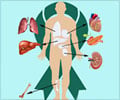Powerful immune molecule is effective in protecting transplanted organs. The human leukocyte antigen G dimer or HLA-G dimer is the powerful immune molecule. The test model developed by the research team could be used as an additional tool for donor-recipient compatibility.
Highlights:
- HLA-G dimer, a powerful immune molecule, is effective in protecting transplanted organs
- Lesser medicines and better outcomes for transplants patients would be possible
- The test model developed by the research team could be used as an additional tool for donor-recipient compatibility
Read More..
Human Leukocyte Antigen G Dimer
The human leukocyte antigen G or HLA-G gene mostly remains inactive in the body until it has to play the role of enabling a fetus. Fetuses have genetic materials from both parents and the HLA-G protects them from being targeted by the mother's immune system. The HLA-G dimer is a combination of two HLA-G molecules and is the most powerful HLA-G, says Dr. Anatolij Horuzsko, Immunologist at the Medical College of Georgia and Georgia Cancer Center at Augusta University and the corresponding author of the study. Dr. Horuzsko adds that this targeted and protective role of HLA-G, as established in the study, is evidence that it could be an effective therapy for protecting transplanted organs.Similar to the fetus, donor organs and tumors are also seen as foreign materials and attract the attention of cytotoxic T cells, or killer T cells. These cells primarily attack the invaders by inducing two molecules - granzyme and perforin. These molecules work together to cause the self-destruction of cells in transplanted organs and produce inflammation that could lead to further destruction.
Gun Barrel and Bullet Analogy
Dr. Horuzsko uses an analogy involving a gun barrel and bullet to explain the roles of the two effector molecules. Similar to a barrel, the perforin creates a path that targets the cell and the granzyme B acts as the bullet that shoots through. In certain patients, whose immune system maybe insufficient, granzymes may act alone. Cells that are rendered dead as a result of such an attack may trigger inflammation and granzymes themselves trigger inflammation directly, thereby, hurting the organ.Around 15 percent of patients who have undergone kidney transplants will experience cytotoxic T cell attack within 5 years of the transplant. This may happen despite the best efforts to match donors and recipient and use of drugs to suppress the immune response. Dr. Horuzsko and his team have been able to understand partly, the role of HLA-G dimer in tackling the immune molecules and overcome the cytotoxic T cells that produce these molecules.
The Study
To understand the impact of HLA-G dimer, the research team measured the plasma level of 40 patients whose organs were rejected and 90 patients who were doing well. Significantly higher levels of HLA-G dimer were found in patients doing well, without any clear picture of demographic factors like age or race indicating naturally higher levels of the molecule.Genetic analysis also confirmed that HLA-G dimer directly down-regulated the expression of the granzyme B gene. Activation of the killer T cells and granzyme B by HLA-G dimer were considerably restricted in a transgenic mouse developed by the team that expresses human LILRB1, which is considered the primary receptor for HLA-G.
When the cytotoxic T-cells of healthy individuals, contained in a dish, were activated by a lectin known to attract the attention of the immune system, almost half of the resulting killer cells were found positive for granzyme B. When the blood cells of healthy volunteers were penetrated with HLA-G dimer, it was noted that granzyme B was downregulated and the killer T cells present were less capable of their targeted kills. The team found an increased number of HLA-G dimer receptors on the killer cells. This suggests that granzymes and perforin aimed at the new organ did not act and the protective nature of HLA-G as gauged by the research team is accurate.
‘Humanized’ Mouse Model
The research team developed a ‘humanized’ mouse, a living model of a human transplant with the immune system of one person being given cells from another. On using this mouse model, Dr. Horuzsko mentioned, “It provides an environment that is much closer to what we see in a patient.”Similar to patients with naturally high levels of HLA-G, giving HLA-G dimer also interferes with the killer instincts of T cells. “It's more evidence this mechanism is working in a real situation,” says Dr. Horuzsko.
In a transplant, where the match is less than ideal, white blood cells, an initial indicator of immune response, show up as early as when a new organ is transplanted in the operating room. Typically, this might happen over the course of a week or so as the recipient's immune system naturally produces what Dr. Horuzsko refers to as an ‘orchestra’ of immune cells, where the cytotoxic T cells are the most powerful players. He says, “It’s a very dynamic process.”
Future of Humanized Models in Transplants
In the future these humanized models could be used as an additional test for compatibility of donor and recipient, says Dr. Horuzsko. They could help in determining the type and volume of drugs that would work best for individual patients. “We are talking about a living test of organ compatibility. This is the future of personalized medicine” he remarks, observing that higher levels of HLA-G dimer and less response to the donor organ would mean less medicine and better outcomes.Observations of the Research Team
Presently the therapies used to help in evading organ rejection include enhancing the recipient-donor match and prescribing drugs to suppress the immune response, which can make patients susceptible to infections and cancer.The dimer, though very powerful, is also vulnerable and could break apart easily, Dr. Hurzsko mentions. Speaking of the tasks that need to be completed before clinical trials commence, he says, “We need to generate a stable, unbreakable HLA-G dimer.”
Naturally high levels of HLA-G may not increase an individual’s risk of developing cancer but would reduce the immune system’s ability to fight cancer, if developed. Small tumors do not attract the attention of HLA-G dimer.
Following a kidney transplant, HLA-G levels would increase in most patients not necessarily to protect the transplanted organ, but as a natural balance to the immune response which boosts as a reaction to the presence of foreign material.
Dr. Horuzsko says that granzyme B, similar to HLA-G, remains idle in the body until it is required to kill a virus picked up from dirt or bacteria on a sandwich. HLA studies are already being used to help identify good, matching donors.
Reference:
- Molecule silences barrel, bullet pointed at transplanted organ - (https://jagwire.augusta.edu/archives/60880)
Source-Medindia











